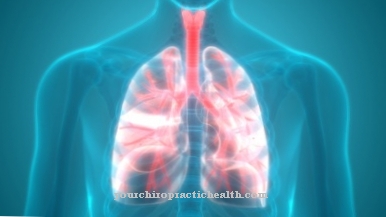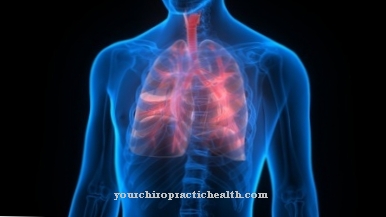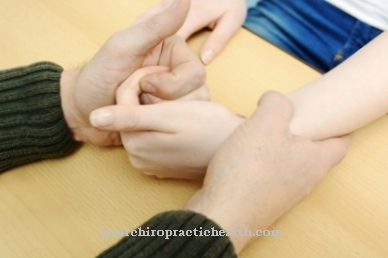Under the Babinski reflex neurology understands a pathological pelvic reflex from the group of pyramidal tract signs. This reflex group points to damage to the motor neurons that control human motor skills. Such damage can occur in the context of diseases such as multiple sclerosis (MS) and amyotrophic lateral sclerosis (ALS).
What is the Babinski Reflex?

The Bambinski reflex is a pathological joint reflex that can occur when the lateral edge of the foot is wiped. The reflex movement is also called the Babinski sign and is a pyramid orbit sign from the Babinski reflex group. In adults, it is a pathological reflex that indicates a neuronal disease. Other names for the phenomenon are the Big toe reflex or Toe reflex.
The pyramidal tract signs are usually interpreted as an indication of lesions of the motor neurons. These efferent neurons conduct bioelectrical impulses as action potentials out of the central nervous system and conduct them into the muscle fibers. The motor neurons are thus the switching point for body movements. Both voluntary movements and reflex movements are interconnected via the neurons. The first motor neuron is located in the motor cortex of the brain. The lower motor neuron, on the other hand, is located in the anterior horn of the spinal cord.
The Babinski reflex can appear as a symptom of any type of damage to the two motor neurons. This means that both inflammation and degenerative phenomena can be the primary cause of the pathological reflex.
The Babinski reflex was named after Joseph François Félix Babinski. The French neurologist first associated the big toe reflex with neuronal diseases in the 19th century.
Function & task
Human reflexes are motor reflexes that have an evolutionary background. Most of them are protective reflexes, for example the eyelid closing reflex, which is supposed to protect the eyeball and thus the visual system. When something approaches the eye, the eyelid involuntarily and automatically closes. The cough reflex also has a protective function. It is triggered when the lining of the airways is strongly irritated. Liquids and food residues are said to be expelled from the airways in the event that a person chokes. The cough reflex protects the organism from suffocation.
Humans can only influence their reflexes to a certain extent and are only aware of them to a limited extent. Reflexes change with age. For example, an adult has far fewer reflexes than an infant. Babies, for example, have a sucking reflex. The teat movement is triggered as soon as the baby's mouth is touched. It is irrelevant whether the breast, a finger or even an object such as the pacifier actually touches the baby's mouth. The suckling reflex disappears after a certain age. The time until reflex loss can vary from person to person. On average, suckling can no longer be triggered from around the age of one year.
In addition to the sucking reflex, babies have numerous more reflexes. One of them is also the Babinski reflex. When the lateral edge of the foot of babies is stroked, their big toe stretches upwards and the other limbs of the toes make a grasping movement at the same time. At this stage of development, the muscle groups in the limbs are still activated together. Like the suckling reflex, the Babinski reflex disappears from an average age of one year.
From this age on, the motor skills are subject to a higher-level control, which allows the separate activation of the individual muscle groups. This control is exercised through the upper and lower motor neurons. So if the Babinski reflex can be observed in adults, there is a loss of superordinate control and the muscle groups that were previously activated together can therefore be activated again at the same time.
Illnesses & ailments
The Babinski reflex is considered a symptom by neurologists. In the past, the pathological reflex was much more important than it is today. In the meantime, the mere presence of the Babinski mark on one or both feet is not rated as a diagnosis. Therefore, the reflex is only interpreted today in combination with other reflexes of the Babinski group and against the background of other findings as a solid indication of damage to the motor neurons. Another reflex of the Babinski group is, for example, the Gordon reflex.
Noticeable findings can be paralysis, muscle weakness, unsteady gait or spasticity. If the Babinski reflex, but only the upward movement of the big toe, cannot be triggered by brushing, this alone is not sufficient for a suspected diagnosis of lesions on the motor neurons. In the case of lesions of the first motor neuron, there are accompanying spastic phenomena. If, on the other hand, a suspected diagnosis of damage to the second motor neuron is made, muscle weakness or paralysis can be observed.
Both neurons can be damaged by central nervous system diseases such as ALS or MS. In the autoimmune disease multiple sclerosis, immunological inflammation is responsible for the lesions.The degenerative disease of amyotrophic lateral sclerosis, on the other hand, progressively degenerates the motor system and thus attacks both the brain and the spinal cord.
The reflex examination is a standard procedure in neurological diagnostics. If pathological reflexes can be determined, this is not only diagnostic, but often also prognostic. In multiple sclerosis, pyramidal orbital signs such as the Babinski reflex are assessed as factors in an unfavorable prognosis if they occur at the beginning of the disease.



























